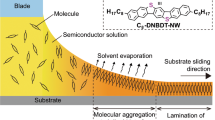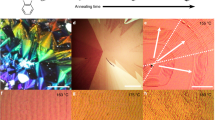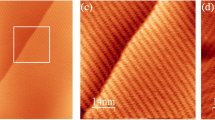Abstract
The supramolecular organization of organic semiconductors on the dielectric layer of thin-film field-effect transistors is a crucial factor in achieving good device performance. Charge transport in these devices occurs near the interface with the gate dielectric. By confocal spectroscopy and microscopy we study the supramolecular organization in ultra-thin films of a prototype organic semiconductor, α-sexithiophene, on silicon dioxide, a widely used transistor gate dielectric. We demonstrate that in submonolayer films of sexithiophene (T6), regions where the molecules stand on their long molecular axis coexist with regions where the molecules lie flat on the substrate. When the first monolayer is completed, all T6 molecules stand on the substrate, and the flat molecules detected in the submonolayer films are no longer present. In films thicker than two monolayers, the photoluminescence spectra of standing molecules show a molecular H-like aggregation as in the single crystal.
This is a preview of subscription content, access via your institution
Access options
Subscribe to this journal
Receive 12 print issues and online access
$259.00 per year
only $21.58 per issue
Buy this article
- Purchase on Springer Link
- Instant access to full article PDF
Prices may be subject to local taxes which are calculated during checkout




Similar content being viewed by others
References
Sirringhaus, H., Tessler, N. & Friend, R. H. Integrated optoelectronic devices based on conjugated polymers. Science 280, 1741–1744 (1998).
Gundlach, D. J., Lin, Y. Y., Jackson, T. N., Nelson, S. F. & Schlom, D. G. Pentacene organic thin-film transistors - Molecular ordering and mobility. IEEE Electron Device Lett. 18, 87–89 (1997).
Shaheen, S. E. et al. 2.5% efficient organic plastic solar cells. Appl. Phys. Lett. 78, 841–843 (2001).
Peumans, P., Uchida, S. & Forrest, S. R. Efficient bulk heterojunction photovoltaic cells using small-molecular-weight organic thin film. Nature 425, 158–162 (2003).
Friend, R. H. et al. Electroluminescence in conjugated polymers. Nature 397, 121–128 (1999).
Tang, C. W. & VanSlyke, S. A. Organic electroluminescent diodes. Appl. Phys. Lett. 51, 913–915 (1987).
Tsujimura, T. et al. A 20-inch oled display driven by super-amorphous-silicon technology. SID 2003 Tech. Digest 34, 6–9 (2003).
Gelinck, G. H. et al. Flexible active-matrix displays and shift registers based on solution-processed organic transistors. Nature Mater. 3, 106–110 (2004).
Sheraw, C. D. et al. Organic thin-film transistor-driven polymer-dispersed liquid crystal displays on flexible polymeric substrates. Appl. Phys. Lett. 80, 1088–1090 (2002).
Mach, P., Rodriguez, S. J., Nortrup, R., Wiltzius, P. & Rogers, J. A. Monolithically integrated, flexible display of polymer-dispersed liquid crystal driven by rubber-stamped organic thin-film transistors. Appl. Phys. Lett. 78, 3592–3594 (2001).
Sirringhaus, H. et al. Two-dimensional charge transport in self-organized, high-mobility conjugated polymers. Nature 401, 685–688 (1999).
Swiggers, M. L. et al. Orientation of pentacene films using surface alignment layers and its influence on thin-film transistor characteristics. Appl. Phys. Lett. 79, 1300–13002 (2001).
Sundar, V. C. et al. Elastomeric transistor stamps: Reversible probing of charge transport in organic crystals. Science 303, 1644–1646 (2004).
de Boer, R. W. I., Klapwijk, T. M. & Morpurgo, A. F. Field-effect transistors on tetracene single crystals. Appl. Phys. Lett. 83, 4345–4347 (2003).
Klauk, H. et al. High-mobility polymer gate dielectric pentacene thin film transistors. J. Appl. Phys. 92, 5259–5263 (2002).
Horowitz, G. & Hajlaoui, M. E. Mobility in polycrystalline oligothiophene field-effect transistors dependent on grain size. Adv. Mater. 12, 1046–1050 (2000).
Podzorov, V. et al. Intrinsic charge transport on the surface of organic semiconductors. Phys. Rev. Lett. 93, 086602 (2004).
Muccini, M. et al. Interchain interaction in a prototypical conjugated oligomer from polarized absorption at 4.2 K: alpha-sexithienyl single crystal. J. Chem. Phys. 109, 10513–10520 (1998).
Muccini, M. et al. Polarized fluorescence in alpha-sexithienyl single crystal at 4.2 K. J. Chem. Phys. 108, 7327–7333 (1998).
Loi, M. A. et al. Primary optical excitations and excited-state interaction energies in sexithiophene. Phys. Rev. B 66, 113102 (2002).
Horowitz, G., Fichou, D., Peng, X., Xu, Z. & Garnier, F. A field-effect transistor based on conjugated alpha-sexithyenil. Solid State Commun. 72, 381–384 (1989).
Mushrush, M., Facchetti, A., Lefenfeld, M., Katz, H. E. & Marks, T. J. Easily processable phenylene-thiophene-based organic field-effect transistors and solution-fabricated nonvolatile transistor memory elements. J. Am. Chem. Soc. 125, 9414–9423 (2003).
Ostoja, P. et al. Instability in electrical performance of organic semiconductor devices. Adv. Mater. Opt. Electron. 1, 127–132 (1992).
Dinelli, F., Murgia, M., Levy, P., Cavallini, M. & Biscarini, F. Spatially correlated charge transport in organic thin film transistors. Phys. Rev. Lett. 92, 116802 (2004).
Servet, B. et al. Polymorphism and charge-transport in vacuum-evaporated sexithiophene films. Chem. Mater. 6, 1809–1815, 1994.
Ostoja, P. et al. Electrical characteristics of field-effect transistors formed with ordered α-sexithienyl. Synth. Met. 54, 447–452 (1993).
Lovinger, A. J. et al. Morphology of alpha-hexathienyl thin-film-transistor films. J. Mater. Res. 10, 2558–2562 (1995).
Biscarini, F., Zamboni, R., Samorì, P., Ostoja, P. & Taliani, C. Growth of conjugated oligomer thin-films studied by atomic-force microscopy. Phys. Rev. B 52, 14868–14877 (1995).
Muccini, M., Murgia, M., Biscarini, F. & Taliani, C. Morphology controlled energy transfer in conjugated molecular thin films. Adv. Mater. 13, 355–358 (2001).
Horowitz, G. et al. Growth and characterization of sexithiophene single-crystals. Chem. Mater. 7, 1337–1341 (1995).
Loi, M. A., Da Como, E., Zamboni, R., & Muccini, M. Nanoscale femtosecond spectroscopy for material science and nanotechnology. Synth. Met. 139, 687–690 (2003).
Degli Esposti, A., Fanti, M., Muccini, M., Taliani, C. & Ruani, G. The polarized infrared and Raman spectra of alpha-T6 single crystal: An experimental and theoretical study. J. Chem. Phys. 112, 5957–5969 (2000).
Kouki, F., Spearman, P., Valat, P., Horowitz, G. & Garnier, F. Experimental determination of excitonic levels in alpha-oligothiophenes. J. Chem. Phys. 113, 385–391 (2000).
Pope, M. & Swenberg, C. E. Electronic Processes in Organic Crystals (Oxford Univ. Press, New York, 1982).
Porzio, W., Destri, S., Mascherpa, M. & Brückner, S. Structural aspects of olygothiophene series from x-ray-powder diffraction data. Acta Polym. 44, 266–272 (1993).
Loi, M. A. et al. Ultrafast formation of nonemissive species via intermolecular interaction in single crystals of conjugated molecules. Phys. Rev. Lett. 86, 732–735 (2001).
Acknowledgements
The valuable technical support of P. Fancello, P. Mei and T. Bonfiglioli is kindly acknowledged. We thank C. Taliani for useful discussions. Work was supported by the EU FET-IST program under contract IST-2001-33057 (ILO), IST-2001-38919 (PHOENIX) and by EU-G5RD-CT2000-00349 (MONA-LISA).
Author information
Authors and Affiliations
Corresponding authors
Ethics declarations
Competing interests
The authors declare no competing financial interests.
Rights and permissions
About this article
Cite this article
Loi, M., da Como, E., Dinelli, F. et al. Supramolecular organization in ultra-thin films of α-sexithiophene on silicon dioxide. Nature Mater 4, 81–85 (2005). https://doi.org/10.1038/nmat1279
Received:
Accepted:
Published:
Issue Date:
DOI: https://doi.org/10.1038/nmat1279
This article is cited by
-
Alternative Face-on Thin Film Structure of Pentacene
Scientific Reports (2019)
-
Preparation of functionalized protein materials assisted by mechanochemistry
Journal of Materials Science (2018)
-
In-Situ GISAXS Study of Supramolecular Nanofibers having Ultrafast Humidity Sensitivity
Scientific Reports (2017)
-
Organic light-emitting transistors with an efficiency that outperforms the equivalent light-emitting diodes
Nature Materials (2010)
-
Improved structural ordering in sexithiophene thick films grown on single crystal oxide substrates
Applied Physics A (2009)



